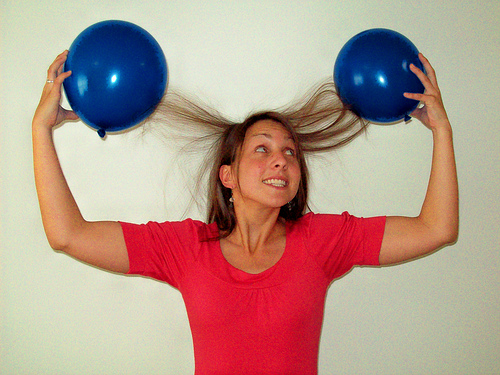The triboelectric effect is a type of contact electrification in which certain materials become electrically charged after they come into contact with another different material through friction. Rubbing glass with fur, or a comb through the hair, can build up triboelectricity. Most everyday static electricity is triboelectric. The polarity and strength of the charges produced differ according to the materials, surface roughness, temperature, and other properties.
 TriboElectric Table
TriboElectric Table
| Column 1 (this col.): Insulator name. Col.2: Charge affinity in nC/J (nano ampsec/wattsec of friction). Col.3: Charge acquired if rubbed with metal (W=weak, N=normal, or consistent with the affinity). Col.4: Notes. | Affinity nC/J | Metal effect | Triboelectric Table Tests were performed by Bill Lee (Ph.D., physics). ©2009 by AlphaLab, Inc. (TriField.com), which also manufactured the test equipment used. This table may be reproduced only if reproduced in whole. |
|
Polyurethane foam |
+60 |
+N |
All materials are good insulators (>1000 T ohm cm) unless noted. |
|
Sorbothane |
+58 |
-W |
Slightly conductive. (120 G ohm cm). |
|
Box sealing tape (BOPP) |
+55 |
+W |
Non-sticky side. Becomes more negative if sanded down to the BOPP film. |
|
Hair, oily skin |
+45 |
+N |
Skin is conductive. Cannot be charged by metal rubbing. |
|
Solid polyurethane, filled |
+40 |
+N |
Slightly conductive. (8 T ohm cm). |
|
Magnesium fluoride (MgF2) |
+35 |
+N |
Anti-reflective optical coating. |
|
Nylon, dry skin |
+30 |
+N |
Skin is conductive. Cannot be charged by metal rubbing. |
|
Machine oil |
+29 |
+N |
|
|
Nylatron (nylon filled with MoS2) |
+28 |
+N |
|
|
Glass (soda) |
+25 |
+N |
Slightly conductive. (Depends on humidity). |
|
Paper (uncoated copy) |
+10 |
-W |
Most papers & cardboard have similar affinity. Slightly conductive. |
|
Wood (pine) |
+7 |
-W |
|
|
GE brand Silicone II (hardens in air) |
+6 |
+N |
More positive than the other silicone chemistry (see below). |
|
Cotton |
+5 |
+N |
Slightly conductive. (Depends on humidity). |
|
Nitrile rubber |
+3 |
-W |
|
|
Wool |
0 |
-W |
|
|
Polycarbonate |
-5 |
-W |
|
|
ABS |
-5 |
-N |
|
|
Acrylic (polymethyl methacrylate) and adhesive side of clear carton-sealing and office tape |
-10 |
-N |
Several clear tape adhesives are have an affinity almost identical to acrylic, even though various compositions are listed. |
|
Epoxy (circuit board) |
-32 |
-N |
|
|
Styrene-butadiene rubber (SBR, Buna S) |
-35 |
-N |
Sometimes inaccurately called “neoprene” (see below). |
|
Solvent-based spray paints |
-38 |
-N |
May vary. |
|
PET (mylar) cloth |
-40 |
-W |
|
|
PET (mylar) solid |
-40 |
+W |
|
|
EVA rubber for gaskets, filled |
-55 |
-N |
Slightly conductive. (10 T ohm cm). Filled rubber will usually conduct. |
|
Gum rubber |
-60 |
-N |
Barely conductive. (500 T ohm cm). |
|
Hot melt glue |
-62 |
-N |
|
|
Polystyrene |
-70 |
-N |
|
|
Polyimide |
-70 |
-N |
|
|
Silicones (air harden & thermoset, but not GE) |
-72 |
-N |
|
|
Vinyl: flexible (clear tubing) |
-75 |
-N |
|
|
Carton-sealing tape (BOPP), sanded down |
-85 |
-N |
Raw surface is very + (see above), but close to PP when sanded. |
|
Olefins (alkenes): LDPE, HDPE, PP |
-90 |
-N |
UHMWPE is below. Against metals, PP is more neg than PE. |
|
Cellulose nitrate |
-93 |
-N |
|
|
Office tape backing (vinyl copolymer ?) |
-95 |
-N |
|
|
UHMWPE |
-95 |
-N |
|
|
Neoprene (polychloroprene, not SBR) |
-98 |
-N |
Slightly conductive if filled (1.5 T ohm cm). |
|
PVC (rigid vinyl) |
-100 |
-N |
|
|
Latex (natural) rubber |
-105 |
-N |
|
|
Viton, filled |
-117 |
-N |
Slightly conductive. (40 T ohm cm). |
|
Epichlorohydrin rubber, filled |
-118 |
-N |
Slightly conductive. (250 G ohm cm). |
|
Santoprene rubber |
-120 |
-N |
|
|
Hypalon rubber, filled |
-130 |
-N |
Slightly conductive. (30 T ohm cm). |
|
Butyl rubber, filled |
-135 |
-N |
Conductive. (900 M ohm cm). Test was done fast. |
|
EDPM rubber, filled |
-140 |
-N |
Slightly conductive. (40 T ohm cm). |
|
Teflon |
-190 |
-N |
Surface is fluorine atoms– very electronegative. |
Symbols in the table— Polyurethane (top) tends to charge positive; teflon (bottom) charges negative. The charge affinity listings show relative charging. Two materials with almost equal charge affinity tend not to charge each other much even if rubbed together. Column 3 shows how each material behaves when rubbed against metal, which is much less predictable and repeatable than insulator-to-insulator rubbing. The charging by metal is strongly dependent on the amount of pressure used, and sometimes will even reverse polarity. At very low pressure (used in this table), it is fairly consistent. A letter “N” (normal) in this column means the charge affinity against metal is roughly consistent with the column 2 value. The letter “W” means weaker than expected (i.e., closer to zero than expected or even reversed.) The “+” or “-” indicates the polarity. In all cases where the polarity in col.3 disagrees with col.2, it is a weak (W) effect.


